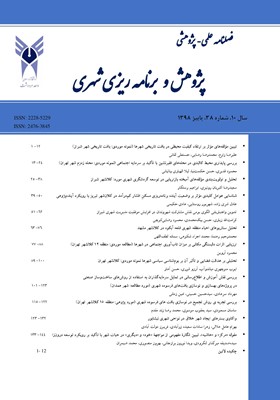تحلیل تأثیر توریسم در تغییر کاربری اراضی شهر اردکان فارس
محورهای موضوعی : فصلنامه علمی و پژوهشی پژوهش و برنامه ریزی شهری
عبدالمطلب رهنما
1
,
احمد خادم الحسینی
2
,
امیر گندمکار
3
![]()
1 - مرکز تحقیقات گردشگری، گروه جغرافیا، واحد نجفآباد، دانشگاه آزاد اسلامی، نجفآباد، ایران
2 - مرکز تحقیقات گردشگری، گروه جغرافیا، واحد نجفآباد، دانشگاه آزاد اسلامی، نجفآباد، ایران
3 - مرکز تحقیقات گردشگری، گروه جغرافیا، واحد نجفآباد، دانشگاه آزاد اسلامی، نجفآباد، ایران
کلید واژه: گردشگری, تغییرات کاربری زمین, تخریب منابع طبیعی و گردشگری, اردکان فارس,
چکیده مقاله :
در دهههای اخیر به سبب فعالیتهای گردشگری و نوسانهای شدید محیطی، وضعیت کاربری زمین در حال تغییر است. از اینرو برای حفاظت و صیانت از نواحی گردشگری، بررسی وضعیت کاربری زمین در مقاصد گردشگری ضروری میباشد. بخش اردکانِ استان فارس یکی از قطبهای گردشگری کشور است که در چندسالِ گذشته با تغییر کاربریهای مختلفی مواجه شده است. هدف از مطالعه حاضر، بررسی نقش گردشگری در بروز تغییرات کاربری زمین در نواحی محدوده و حریم شهر اردکان در استان فارس میباشد. به همین منظور اطلاعات مربوط به وضع موجود و تغییرات صورت گرفته در کاربریهای بخش اردکان طی دوره زمانی 1376 تا 1397 جمعآوری شد. پس از جمعآوری و تحلیل نقشههای پایه و بررسی عکسهای هوایی و همچنین مصاحبه با ساکنان محلی و گردشگران، جهت ارزیابی تاثیر توریسم در تغییر کاربری اراضی منطقه مورد مطالعه، از روش تحقیق ِ توصیفی و تحلیلی مبتنی بر پیمایش استفاده گردید. براساس نتایج، گردشگری در حوزه مورد مطالعه، با ایجاد تغییرات گسترده در کاربریهای اراضی، بویژه اراضی زراعی، باغات، اراضی حریم رودخانه، تخریب منابع طبیعی و گردشگری در دهههای اخیر را به دنبال داشته است. همچنین نتایج نشان داد بیشترین تغییرات کاربریها به ترتیب مربوط به ساخت مجتمعهای گردشگری (55/50 درصد)، تبدیل اراضی باغی به اراضی دیم (9/16 درصد)، تبدیل باغهای سطح شهر به کاربری مسکونی (11/4 درصد)، تبدیل باغهای سطح شهر به خانه دوم (8/12 درصد) و تغییر کاربریهای باغ به صنعتی (64/5) بوده است. علاوه براین، نتایج آماری از مجموعه تغییرات پیش آمده نشان میدهد سهم ساخت و سازهای مربوط به مجتمعهای گردشگری با 55/50 درصد بیشترین سهم را داشته و بعد از آن تبدیل اراضی باغی به اراضی دیم به 9/16 درصد و تبدیل باغهای سطح شهر به کاربری مسکونی و خانههای دوم در اولویتهای بعدی با 11/14 درصد و 8/12 درصد قرار گرفته است. در پایان، با توجه به نتایج حاصل از مطالعه، پیشنهادات سیاستی در زمینه طراحی مناسب در رابطه با ساماندهی مجتمعهای گردشگری و اتخاذ تمهیدات لازم برای جلوگیری از تخریب باغها در منطقه ارائه گردید.
In recent decades, due to tourism activities and severe environmental fluctuations, the land use situation is changing. Therefore, in order to protect and preserve tourist areas, it is necessary to study the status of land use in tourism purposes. Ardakan section of Fars province is one of the tourism hubs of the country that has faced various uses in the past few years. The purpose of this study is to investigate the role of tourism in land use change in the area of Ardakan city in Fars province. For this purpose, information about the current situation and changes in the uses of Ardakan section during the period 1376 to 1397 were collected. After collecting and analyzing the basic maps and reviewing the aerial photographs as well as interviewing local residents and tourists, a descriptive and analytical survey method based on survey was used to evaluate the impact of tourism on land use change in the study area. According to the results, tourism in the study area has led to the destruction of natural resources and tourism in recent decades by making extensive changes in land uses, especially agricultural lands, orchards, river lands. The results also showed that the most land use changes were related to the construction of tourism complexes (50.55%), conversion of garden lands to rainfed lands (16.9%), conversion of city gardens to residential use (4.11%), conversion of gardens, respectively. The city level was to the second house (12.8%) and the change of garden uses was industrial (5.64). In addition, the statistical results of the set of changes show that the share of constructions related to tourist complexes with 50.55% had the highest share, followed by the conversion of garden lands to rainfed lands to 16.9% and the conversion of city gardens to Residential use and second homes are in the next priorities with 14.11% and 12.8%. Finally, according to the results of the study, policy proposals in the field of appropriate design in relation to the organization of tourist complexes and take the necessary measures to prevent the destruction of gardens in the region were presented.
_||_


